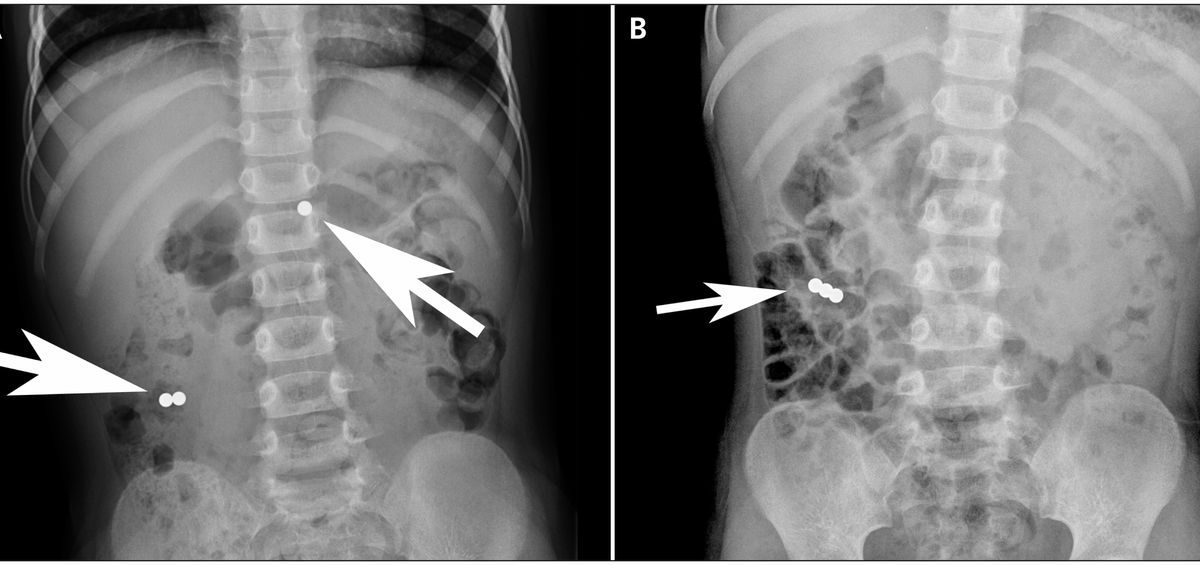
5 causes of non-cardiac chest pain
16th June 2022
Acute Medical Problems in Pregnancy
7th July 2022This guidance relates specifically to the ingestion by young children of Neodymium magnets, also known as super-strong or rare earth magnets, which are used in the manufacturing of many household items.
These are often attractive to youngsters and their tiny size, usually less than 6mm in diameter, has led to an increase in the UK in accidental ingestions.
Potential Harms of Magnet Ingestion
Where multiple magnets are ingested or if one is swallowed along with a metal object there can be significant ischemic injury and pressure necrosis to the gut or bowel.
Injuries can include ulceration, necrosis, perforation, rupture, fistula, haemorrhage, mediastinitis, gastric outlet, bowel obstruction, volvulus, sepsis and ultimately death.
A single button battery of the type used in watches, remote controls and the like can create a chemical reaction with the saliva to form a substance similar to caustic soda and can cause severe burning of tissue. Therefore, it is vital that in cases where children present with gastrointestinal symptoms that magnetic ingestion is considered and investigated in a time-critical manner.
Risk Factors for Complications Post-ingestion of Magnets
1. Those who have co-ingested a magnet with a button battery
2. Ingestion of multiple magnets, or a magnet with a metal object
3. Children and young people with psychiatric, development or behavioural problems
4. Delayed presentation (12 hours or more)
5. Ceramic or ferric magnets ingested with a metal object
Presentation
A suspected magnet ingestion case will require urgent discussion with a tertiary paediatric surgical team, and where there is a history of magnet ingestion, surgical intervention is highly likely.
Perforation is likely to occur in 50-75% of symptomatic patients and fistula formation can occur within 2-5 days.
Where a patient presents with wheezing or noisy breathing, drooling, coughing, difficulty swallowing, choking or gagging when eating or drinking, abdominal pain, decreased appetite or refusal to eat, you should always consider and investigate the possibility of magnet ingestion or aspiration.
Even though abdominal symptoms may take several weeks to appear after ingestion, intestinal injury can occur within 8-24 hours.
Management of a Patient Presenting With Magnet Ingestion
Do not use metal detectors in the assessment of children where magnet ingestion is suspected.
Monitoring of progression through the GI tract is essential to the decision on any surgical intervention. X-rays to the chest and abdomen, with the patient lying down, preferably AP, are essential to determine the presence and position of any magnet(s). Where a single magnet is identified, a lateral abdominal x-ray should be requested for confirmation, as misdiagnosis of multiple magnets as a solitary magnet can result in complications.
Discharged Patients
These require follow-up imaging after 6-12 hours with AXR (only repeat CXR if magnets are present in the first image.) Repeat x-rays should be done with the patient lying down, ideally AP and at least 6-12 hours apart until it is shown and confirmed that the magnet has passed through the stomach and is progressing through the small bowel or beyond. X-ray interpretation and progression through the GI tract should be confirmed by a radiologist.
Where patients do not meet the criteria for discharge, admission to the care of a local paediatric surgical team may be appropriate to enable close observation and further x-rays.




